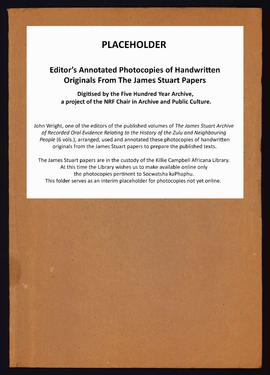- Item
- 2018 -
Parte de FHYA curation of items derived from the James Stuart Papers at the Killie Campbell Africana Library
[Source - Carolyn Hamilton for FHYA, 2019: John Wright, one of the editors of the published volumes of The James Stuart Archive of Recorded Oral Evidence Relating to the History of the Zulu and Neighbouring People (6 vols.), arranged, used and annotated these photocopies of handwritten originals from the James Stuart Papers to prepare the published texts.
The Killie Campbell Africana Library, which holds the original handwritten notes, has given permission for the photocopies pertinent to only one interlocutor, Socwatsha kaPhaphu, to be made available online. We are thus currently unable to provide the annotated photocopies of the handwritten originals for this interlocutor.
The full set of John Wrights' annotated photocopies of the handwritten originals for all interlocutors should ideally be available at the link in the Associated materials field below. However due to KCAL's limited permissions only a circumscribed version is currently available.]

